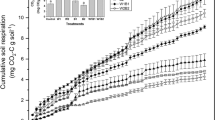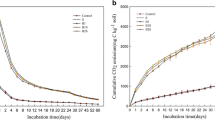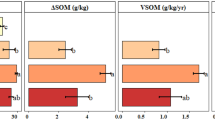Abstract
The object of this study was to explore the effect of biochar on Loess Plateau calcareous arable soil organic carbon mineralization under the condition of with or without nitrogen-fertilizer addition. Maize straw–derived biochars were prepared at 400 and 800 °C (BC400 and BC800), respectively. After physicochemical property determination, biochars were thoroughly mixed with soil at the mass ratio of 1% and 2% respectively, and a control without biochar addition was also arranged. Each treatment was carried out with 6 replicates, half of which were subjected to nitrogen-fertilizer addition. After 1-week preincubation, 50-day indoor static soil incubation experiment was carried out consecutively. Results showed that compared with BC400, pH, carbon content, alkaline oxygen-containing functional group, and specific surface area of BC800 significantly increased, while dissolved organic carbon, nitrogen, hydrogen, oxygen contents, carboxyl, carbonyl, and acidic oxygen-containing functional group significantly decreased. In the treatments without nitrogen-fertilizer addition, maize straw–derived biochar inhibited CO2 emission, especially for BC800-1% and BC800-2%. However, in the treatments with nitrogen-fertilizer addition, the biochar promoted CO2 emission, especially for BC400-1% and BC400-2%. Moreover, the pyrolysis temperature of biochar preparation showed more crucial impact on CO2 emission than its application rate. CO2 emission was significantly correlated with total organic carbon/inorganic nitrogen (TOC/IN) and dissolved organic carbon/inorganic nitrogen (DOC/IN). However, DOC/IN explained the variance of CO2 emission with a higher degree than TOC/IN. Carbon/nitrogen mass ratio was the key factor in controlling CO2 emission from biochar-amended soil, and DOC/IN showed more significant effect on CO2 emission than TOC/IN.







Similar content being viewed by others
References
Amin AA (2020) Bagasse pith-vinasse biochar effects on carbon emission and nutrient release in calcareous sandy soil. J Soil Sci Plant Nutr 20:220–231
APHA, AWWA, WEF (2012) Standard methods for the examination of water and wastewater, 22th edn. American Public Health Association, Washington, DC
Bao S (2000) Soil agro-chemistrical analysis, 3rd edn. China Agriculture Press, Beijing (in Chinese)
Barracosa P, Cardoso I, Marques F, Pinto A, Oliveira J, Trindade H, Rodrigues P, Pereira JLS (2020) Effect of biochar on emission of greenhouse gases and productivity of cardoon crop (Cynara cardunculus L.). J Soil Sci Plant Nutr 20. https://doi.org/10.1007/s42729-020-00242-w
Boehm HP (1994) Some aspects of the surface chemistry of carbon blacks and other carbons. Carbon 32:759–769
Brandão M, Milà i Canals L, Clift R (2011) Soil organic carbon changes in the cultivation of energy crops: implications for GHG balances and soil quality for use in LCA. Biomass Bioenergy 35:2323–2336
Bruun EW, Ambus P, Egsgaard H, Hauggaard-Nielsen H (2012) Effects of slow and fast pyrolysis biochar on soil C and N turnover dynamics. Soil Biol Biochem 46:73–79
Chen J, Liu X, Zheng J, Zhang B, Lu H, Chi Z, Pan G, Li L, Zheng J, Zhang X, Wang J, Yu X (2013) Biochar soil amendment increased bacterial but decreased fungal gene abundance with shifts in community structure in a slightly acid rice paddy from Southwest China. Appl Soil Ecol 71:33–44
Chen W, Hu X, Lu H (2015) Impacts of biochar input on mineralization of native soil organic carbon. Environ Sci 36:2300–2305 (in Chinese)
Cleveland CC, Townsend AR (2006) Nutrient additions to a tropical rain forest drive substantial soil carbon dioxide losses to the atmosphere. P Natl Acad Sci USA 103:10316–10321
Ding F, Van Zwieten L, Zhang W, Weng Z, Shi S, Wang J, Meng J (2018) A meta-analysis and critical evaluation of influencing factors on soil carbon priming following biochar amendment. J Soils Sediments 18:1507–1517
Durenkamp M, Luo Y, Brookes PC (2010) Impact of black carbon addition to soil on the determination of soil microbial biomass by fumigation extraction. Soil Biol Biochem 42:2026–2029
Fang Y, Singh BP, Collins D, Li B, Zhu J, Tavakkoli E (2018) Nutrient supply enhanced wheat residue-carbon mineralization, microbial growth, and microbial carbon-use efficiency when residues were supplied at high rate in contrasting soils. Soil Biol Biochem 126:168–178
Harris ZM, Spake R, Taylor G (2015) Land use change to bioenergy: a meta-analysis of soil carbon and GHG emissions. Biomass Bioenergy 82:27–39
Harter J, Krause HM, Schuettler S, Ruser R, Fromme M, Scholten T, Kappler A, Behrens S (2014) Linking N2O emissions from biochar-amended soil to the structure and function of the N-cycling microbial community. The ISME J 8:660–674
IPCC (2014) Climate change 2014: synthesis report. Contribution of working groups I, II and III to the fifth assessment report of the intergovernmental panel on climate change [Core writing team, Pachauri RK, Meyer LA (eds.)]. IPCC, Geneva, Switzerland, 151 pp
Jia J, Xiong Z (2016) Impact of application of maize stalk-derived biochar on soil properties and N2O, CO2 and CH4 emissions from vegetable fields. J Ecol Rural Environ 32:283–288 (in Chinese)
Jones DL, Murphy DV, Khalid M, Ahmad W, Edwards-Jones G, DeLuca TH (2011) Short-term biochar-induced increase in soil CO2 release is both biotically and abiotically mediated. Soil Biol Biochem 43:1723–1731
Jones DL, Rousk J, Edwards-Jones G, DeLuca TH, Murphy DV (2012) Biochar-mediated changes in soil quality and plant growth in a three year field trial. Soil Biol Biochem 45:113–124
Jones DL, Willett VB (2006) Experimental evaluation of methods to quantify dissolved organic nitrogen (DON) and dissolved organic carbon (DOC) in soil. Soil Biol Biochem 38:991–999
Karimi A, Moezzi A, Chorom M, Enayatizamir N (2019) Chemical fractions and availability of Zn in a calcareous soil in response to biochar amendments. J Soil Sci Plant Nutr 19:851–864
Ke Y, Hu X, Yi Q, Yu Z (2014) Impacts of rice straw biochar on organic carbon and CO2 release in arable soil. Environ Sci 35:93–99 (in Chinese)
Khodadad CLM, Zimmerman AR, Green SJ, Uthandi S, Foster JS (2011) Taxa-specific changes in soil microbial community composition induced by pyrogenic carbon amendments. Soil Biol Biochem 43:385–392
Kong Y, Watanabe M, Nagano H, Watanabe K, Yashima M, Inubushi K (2013) Effects of land-use type and nitrogen addition on nitrous oxide and carbon dioxide production potentials in Japanese Andosols. Soil Sci Plant Nutr 59:790–799
Lal R (2004) Soil carbon sequestration impacts on global climate change and food security. Science 304:1623–1627
Lehmann J, Joseph S (2009) Biochar for environmental management: an introduction. In: Lehmann J, Joseph S (eds) Biochar for environmental management: science and technology. Earthscan Publications Ltd., London, pp 1–12
Li B, Wu L (2018) Soil greenhouse gases emission in response to the C/N. J Agro-Environ Sci 37:2067–2078 (in Chinese)
Liang B, Lehmann J, Sohi SP, Thies JE, O’Neill B, Trujillo L, Gaunt J, Solomon D, Grossman J, Neves EG, Luizão FJ (2010) Black carbon affects the cycling of non-black carbon in soil. Org Geochem 41:206–213
Lu R (1999) Soil agrochemistry analysis methods. China Agricultural Science and Technology Press, Beijing (in Chinese)
Lu WW, Ding WX, Zhang JH, Li Y, Luo JF, Bolan N, Xie ZB (2014) Biochar suppressed the decomposition of organic carbon in a cultivated sandy loam soil: a negative priming effect. Soil Biol Biochem 76:12–21
Luo XX, Wang LY, Liu GC, Wang X, Wang ZY, Zheng H (2016) Effects of biochar on carbon mineralization of coastal wetland soils in the Yellow River Delta, China. Ecol Eng 94:329–336
Luo Y, Durenkamp M, De Nobili M, Lin Q, Brookes PC (2011) Short term soil priming effects and the mineralisation of biochar following its incorporation to soils of different pH. Soil Biol Biochem 43:2304–2314
McLauchlan KK, Hobbie SE (2004) Comparison of labile soil organic matter fractionation techniques. Soil Sci Soc Am J 68:1616–1625
Meyer N, Welp G, Rodionov A, Borchard N, Martius C, Amelung W (2018) Nitrogen and phosphorus supply controls soil organic carbon mineralization in tropical topsoil and subsoil. Soil Biol Biochem 119:152–161
Oo AZ, Sudo S, Akiyama H, Win KT, Shibata A, Yamamoto A, Sano T, Hirono Y (2018) Effect of dolomite and biochar addition on N2O and CO2 emissions from acidic tea field soil. PLoS One 13:e0192235
Powlson DS, Whitmore AP, Goulding KWT (2011) Soil carbon sequestration to mitigate climate change: a critical re-examination to identify the true and the false. Eur J Soil Sci 62:42–55
Santos F, Torn MS, Bird JA (2012) Biological degradation of pyrogenic organic matter in temperate forest soils. Soil Biol Biochem 51:115–124
Sheng H, Zhou P, Zhang Y, Kuzyakov Y, Zhou Q, Ge T, Wang C (2015) Loss of labile organic carbon from subsoil due to land-use changes in subtropical China. Soil Biol Biochem 88:148–157
State Environmental Protection Administration (2002) Methods for monitoring and analysis of water and wastewater, 4th edn. China Environmental Science Press, Beijing (in Chinese)
Sutherland WJ, Clout M, Côté IM, Daszak P, Depledge MH, Fellman L, Fleishman E, Garthwaite R, Gibbons DW, de Lurio J, Impey AJ, Lickorish F, Lindenmayer D, Madgwick J, Margerison C, Maynard T, Peck LS, Pretty J, Prior S, Redford KH, Scharlemann JPW, Spalding M, Watkinson AR (2010) A horizon scan of global conservation issues for 2010. Trends Ecol Evol 25:1–7
Vermeulen SJ, Campbell BM, Ingram JSI (2012) Climate change and food systems. Annu Rev Environ Resour 37:195–222
Warde DA, Nilsson MC, Zackrisson O (2008) Fire-derived charcoal causes loss of forest humus. Science 320:629
Weintraub MN, Schimel JP (2003) Interactions between carbon and nitrogen mineralization and soil organic matter chemistry in arctic tundra soils. Ecosystems 6:129–143
Whitman T, Pepe-Ranney C, Enders A, Koechli C, Campbell A, Buckley DH, Lehmann J (2016) Dynamics of microbial community composition and soil organic carbon mineralization in soil following addition of pyrogenic and fresh organic matter. The ISME J 10:2918–2930
Zimmerman AR, Gao B, Ahn MY (2011) Positive and negative carbon mineralization priming effects among a variety of biochar-amended soils. Soil Biol Biochem 43:1169–1179
Funding
This research was funded by the National Natural Science Foundation of China (No. 41503074) and the Natural Science Foundation of Shanxi Province (No. 201901D111066).
Author information
Authors and Affiliations
Corresponding author
Ethics declarations
Conflict of Interest
The authors declare that they have no conflict of interest.
Additional information
Publisher’s note
Springer Nature remains neutral with regard to jurisdictional claims in published maps and institutional affiliations.
Rights and permissions
About this article
Cite this article
Wang, C., Chang, Z. & Niu, S. Effect of Maize Straw–Derived Biochar on Calcareous Arable Soil Organic Carbon Mineralization Under the Condition of with or Without Nitrogen-Fertilizer Addition. J Soil Sci Plant Nutr 20, 2606–2616 (2020). https://doi.org/10.1007/s42729-020-00326-7
Received:
Accepted:
Published:
Issue Date:
DOI: https://doi.org/10.1007/s42729-020-00326-7




